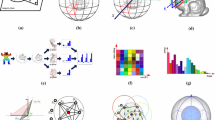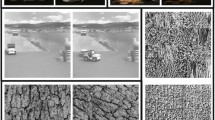Abstract
We explore the performance of a number of popular feature detectors and descriptors in matching 3D object features across viewpoints and lighting conditions. To this end we design a method, based on intersecting epipolar constraints, for providing ground truth correspondence automatically. These correspondences are based purely on geometric information, and do not rely on the choice of a specific feature appearance descriptor. We test detector-descriptor combinations on a database of 100 objects viewed from 144 calibrated viewpoints under three different lighting conditions. We find that the combination of Hessian-affine feature finder and SIFT features is most robust to viewpoint change. Harris-affine combined with SIFT and Hessian-affine combined with shape context descriptors were best respectively for lighting change and change in camera focal length. We also find that no detector-descriptor combination performs well with viewpoint changes of more than 25–30∘.
Similar content being viewed by others
References
Ballester, C. and Gonzalez, M. 1998. Affine invariant texture segmentation and shape from texture by variational methods. Journal of Mathematical Imaging and Vision, 9:141–171.
Beaudet, P.R. 1978. Rotationally invariant image operators. In International Joint Conference on Pattern Recognition, Kyoto, Japan, pp. 579–583.
Belongie, S., Malik, J., and Puzicha, J. 2002. Shape matching and object recognition using shape contexts. In IEEE Transactions on Pattern Analysis and Machine Intelligence.
Bouguet, J.Y. 1999. Visual methods for three-dimensional modeling. PhD thesis, Caltech.
Brown, M. and Lowe, D.G. 2003. Recognising panoramas. In International Conference on Computer Vision.
Carneiro, G. and Jepson, A.D. 2004. Flexible spatial models for grouping local image features. In IEEE Conference on Computer Vision and Pattern Recognition.
Crowley, J.L. and Parker, A.C. 1984. A representation for shape based on peaks and ridges in the difference of low-pass transform. IEEE Transactions on Pattern Analysis and Machine Intelligence, 6:156–168.
Forstner, W. 1986. A feature based correspondence algorithms for image matching. Intl. Arch. Photogrammetry and Remote Sensing, 24:60–166.
Fraundorfer, F. and Bischof, H. 2004. Evaluation of local detectors on non-planar scenes. OAGM/AAPR workshop, Austrian Association for Pattern Recognition.
Freeman, W. and Adelson, E. 1991. The design and use of steerable filters. IEEE Transactions on Pattern Analysis and Machine Intelligence, 13(9):891–906.
Harris, C. and Stephens, M. 1988. A combined corner and edge detector. In Alvey Vision Conference, pp. 147–151.
Hartley, R. and Zisserman, A. 2000. Multiple view geometry in computer vision. Cambridge editor.
Kadir, T., Zisserman, A., and Brady, M. 2004. An affine invariant salient Region Detector. In European Conference on Computer Vision, pp. 228–241.
Ke, Y. and Sukthankar, R. 2004. PCA-SIFT: A more distinctive representation for local image descriptors. In IEEE Conference on Computer Vision and Pattern Recognition.
Leibe, B., Seemann, E., and Schiele, B. 2005. Pedestrian detection in crowded scenes”. In IEEE Conference on Computer Vision and Pattern Recognition, pp. 878–885.
Lindeberg, T. 1994. Scale-space theory: A basic tool for analising structures at different scales. Journal of Applied Statistics, 21(2):225–270.
Lindeberg, T. 1998. Feature detection with automatic scale selection. International Journal of Computer Vision, 30(2):79–116.
Lucas, B.D. and Kanade, T. 1981. An iterative image registration technique with an application to stereo vision. In 7th International Joint Conference on Artificial Intelligence, pp. 674–679.
Lindeberg, T. and Garding, J. 1997. Shape-adapted smoothing in estimation of 3-D shape cues from affine deformations of local 2-D brightness structure. Image and Vision Computing, 15(6):415–434.
Lowe, D.G. 2004. Distinctive image features from scale-invariant keypoints. International Journal of Computer Vision, 60(2):91–110.
Matas, J., Chum, O., Urban, M., and Pajdla, T. 2002. Robust wide baseline stereo from maximally stable extremal regions. British Machine Vision Conference, 384–393.
Mikolajczyk, K. and Schmid, C. 2002. An affine invariant interest point detector. European Conference on Computer Vision.
Mikolajczyk, K. et al. 2004. A comparison of affine region detectors. International Journal of Computer Vision (submitted).
Mikolajczyk, K., Leibe, B., and Schiele, B. 2005. Local features for object class recognition. In International Conference on Computer Vision.
Mikolajczyk, K. and Schmid, C. A performance evaluation of local descriptors. IEEE Transactions on Pattern Analysis and Machine Intelligence (To appear).
Moreels, P. and Perona, P. 2004. Common-frame model for object recognition. In Neural Information Processing Systems.
Moreels, P. and Perona, P. 2005a. Evaluation of features detectors and descriptors based on 3D objects. In International Conference on Computer Vision.
Moreels, P. and Perona, P. 2005b. Probabilistic coarse-to-fine object recognition. Technical report.
Schaffalitzky, F. and Zisserman, A. 2001. Viewpoint invariant texture matching and wide baseline stereo. In International Conference on Computer Vision, pp. 636–643.
Schmid, C. and Mohr, R. 1997. Local greyvalue invariants for image retrieval. IEEE Transactions on Pattern Analysis and Machine Intelligence, 19(5):530–535.
Schmid, C., Mohr, R., and Bauckhage, C. 2000. Evaluation of interest point detectors. International Journal of Computer Vision, 37(2):151–172.
Se, S., Lowe, D.G., and Little, J. 2002. Mobile robot localization and mapping with uncertainty using scale-invariant visual landmarks. International Journal of Robotics Research, 21(8):735–738.
Semple, J.G. and Kneebone, G.T. 1952. Algebraic Projective Geometry. Oxford Science Publication.
Shashua, A. and Werman, M. 1995. On the trilinear tensor of three perspective views and its underlying geomtry. International Conference on Computer Vision.
Shi, J. and Tomasi, C. 1994. Good features to track. IEEE Conference on Computer Vision and Pattern Recognition, Seattle.
Tuytelaars, T. and Van Gool, L. 2000. Wide baseline stereo matching based on local affinely invariant regions. In British Machine Vision Conference.
Tuytelaars, T. and Van Gool, L. 2004. Matching widely separated views based on affine invariant regions. International Journal on Computer Vision, 59(1):61–85.
van Vliet, L.J., Young, I.T., and Verbeek, P.W. 1998. Recursive gaussian derivative filters. In International Conference on Pattern Recognition, pp. 509–514.
Vincent, L. and Soille, P. 1991. Watersheds in digital spaces: an efficient algorithm based on immersion simulations. In IEEE Transactions on Pattern Analysis and Machine Intelligence.
Author information
Authors and Affiliations
Corresponding author
Rights and permissions
About this article
Cite this article
Moreels, P., Perona, P. Evaluation of Features Detectors and Descriptors based on 3D Objects. Int J Comput Vision 73, 263–284 (2007). https://doi.org/10.1007/s11263-006-9967-1
Received:
Revised:
Accepted:
Published:
Issue Date:
DOI: https://doi.org/10.1007/s11263-006-9967-1




